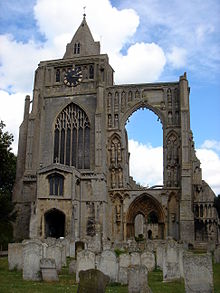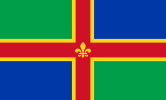Crowland Abbey
| Crowland Abbey | |
|---|---|
 Crowland Abbey | |
 | |
| Denomination | Church of England |
| Churchmanship | Broad Church |
| Website | crowlandabbey.org.uk |
| History | |
| Dedication | Blessed Virgin Mary, Saint Bartholomew and Saint Guthlac, |
| Administration | |
| Parish | Crowland |
| Deanery | Elloe West |
| Diocese | Lincoln |
| Province | Canterbury |
| Clergy | |
| Vicar(s) | Revd Charles Brown |
Crowland Abbey (also spelled Croyland Abbey, Latin: Croilandia) is a Church of England parish church, formerly part of a Benedictine abbey church, in Crowland in the English county of Lincolnshire. It is a Grade I listed building.[1]
History[]
A monk named Guthlac came to what was then an island in the Fens to live the life of a hermit, and he dwelt at Croyland between 699 and 714. Following in Guthlac's footsteps, a monastic community came into being here in the 8th century. Croyland Abbey was dedicated to Saint Mary the Virgin, Saint Bartholomew and Saint Guthlac. During the third quarter of the 10th century, Crowland came into the possession of the nobleman Turketul, a relative of Osketel, Archbishop of York. Turketul, a cleric, became abbot there and endowed the abbey with many estates. It is thought that, about this time, Crowland adopted the Benedictine rule. In the 11th century, Hereward the Wake was a tenant of the abbey.

In 1537, the abbot of Croyland wrote to Thomas Cromwell, sending him a gift of fish: "ryght mekely besychinge yowr Lordshippe favourably to accept the same fyshe, and to be gude and favourable Lord unto me and my poore House."[2] Despite these representations, the abbey was dissolved in 1539. The monastic buildings, including the chancel, transepts and crossing of the church appear to have been demolished fairly promptly but the nave and aisles had been used as the parish church and continued in that role.
During the English Civil War the remains of the abbey were fortified and garrisoned by Royalists in 1642 under governor Thomas Stiles. After a short siege it was taken by Parliamentarian forces under the command of Oliver Cromwell in May 1643.[3][4][5] and this appears to have been when serious damage was done to the abbey's structure. The nave roof fell in 1720, and the main south wall was taken down in 1744. The north aisle of the nave was refurbished and remains in use as the parish church.
Crowland is well known to historians as the probable home of the Croyland Chronicle of Pseudo-Ingulf, begun by one of its monks and continued by several other hands.
The church contains a skull which is identified as the skull of the 9th-century Abbot Theodore, who was killed at the altar by Vikings. The relic used to be on public view until it was stolen from its display case in 1982. The skull was returned anonymously in 1999.
John Clare wrote a sonnet entitled 'Crowland Abbey', which was first published in The Literary Souvenir for 1828 and reprinted in his last book, The Rural Muse in 1835.[6]
List of abbots of Crowland[]
Organ[]
The abbey has a small two manual pipe organ. A specification of the organ can be found on the National Pipe Organ Register.[7]
Bells[]
Crowland Abbey is claimed to have been the first church in England – and among the first in the world – to have a tuned peal or ring of bells (circa 986). According to the Croyland Chronicle, the Abbot Egelric, who died in 984, supplied the peal of bells:
"He also had two large bells made, which he called Bartholomew and Bettelm; also two of middle size, which he called Turketul and Tatwin; and two small ones, to which he gave the names of Pega and Bega. The Lord abbat Turketul had previously had one very large bell made called Guthlac, and when it was rung with the bells before-named, an exquisite harmony was produced thereby; nor was there such a peal of bells in those days in all England."[8]
However, the histories attributed to the 11th-century Abbot Ingulf are now thought to be 14th-century inventions of Pseudo-Ingulf, thus casting doubt on the charming story of the origin of the bells.
Less controversially, the chimes of the present bells were the first to be broadcast on wireless radio by the BBC on 1 November 1925.[9] At 90 feet, the 'pull' or ropes are the longest in England.[10]
Burials[]
- Waltheof II, Earl of Northumbria
- Saint Ælfthryth of Crowland
The churchyard contains the war grave of an airman of the Second World War.[11]
Crowland in Fiction[]
Potter, Jeremy. A Trail of Blood. (New York: McCall, 1970.)
See also[]
References[]
- ^ Historic England. "Crowland Abbey (352270)". Research records (formerly PastScape). Retrieved 13 September 2009.
- ^ Vita beati Franconis e chronico monasterii Villarensis Brabantiae, pervetusto, excerpta et anglice reddita. Hodges-Smith. 1858. p. xx. Retrieved 29 April 2019.
- ^ Blair, David Oswald Hunter (1908). . In Herbermann, Charles (ed.). Catholic Encyclopedia. 4. New York: Robert Appleton Company.
- ^ "Fenland Notes and Queries; April 1899, article on a piece of Parliamentarian propaganda". Archived from the original on 31 August 2010.
- ^ "Bonhams: Civil War – Belvoir Castle". Bonhams. 13 October 2017. Retrieved 13 October 2017.
- ^ "Triumphs of Time: John Clare and the Uses of Antiquity, by Bob Heyes from the John Clare Society Journal, no. 16 (July 1997)". Johnclare.info. Retrieved 17 August 2012.
- ^ "National Pipe Organ Register entry for Crowland".
- ^ Ingulf's Chronicle of the Abbey of Croyland, translated from the Latin by Henry T. Riley. London, 1854.
- ^ "Crowland Abbey bells to feature on BBC Radio 4 'Feedback' programme" Lincoln Diocesan Guild of Church Bell Ringers
- ^ Carr, Barbara. "Bell tower: two firsts + a longest". geograph. Retrieved 16 March 2014.
- ^ CWGC Casualty Record.
Further reading[]
- Alexander, Jenny, "'Sadly Mangled by the Insulting Claws of Time': 13th-Century Work at Croyland Abbey Church", in John McNeil (ed.), King's Lynn and the Fens: Medieval Art, Architecture and Archaeology, British Archaeological Association Conference Transactions, no. 31 (Leeds: Maney Publishing for the British Archaeological Association, 2008), pp. 112–133.
- Alexander, Jenny, "St Guthlac and Company: Saints, Apostles and Benefactors on the West Front of Croyland Abbey Church", in Sue Powell (ed.), Saints and their Cults in the Middle Ages, Proceedings of the Harlaxton Medieval Symposium, no. 32 (Donington: Shaun Tyas, 2017), pp. 249–264.
- Alexander, Jenny, "Crowland Abbey Church and St Guthlac", in Alan Thacker and Jane Roberts (eds.), Guthlac, Crowland's Saint (Donington: Paul Watkins, 2020), pp. 298–315.
- Brady, Lindy, "Crowland Abbey as Anglo-Saxon Sanctuary in the Pseudo-Ingulf Chronicle", , vol. 73 (2018), pp. 19–42. doi: 10.1017/tdo.2018.1
- Bolton, W. F., "The Croyland Quatrefoil and Polychronicon", Journal of the Warburg and Courtauld Institutes, vol. 21, no. 3/4 (1958), pp. 295–296. JSTOR: 750828
- , "The Medieval Network of Navigable Fenland Waterways I: Crowland", Proceedings of the Cambridge Antiquarian Society, vol. 99 (2010), pp. 125–138.
- , In the Shadow of the Abbey: Crowland (Coleford: Douglas McLean, 2013).
- Darby, H. C., The Medieval Fenland (Cambridge: Cambridge University Press, 1940).
- Darby, H. C., The Changing Fenland (Cambridge: Cambridge University Press, 1983).
- Gough, Richard, The History and Antiquities of Croyland-Abbey, in the County of Lincoln (London: J. Nichols, 1783).
- Hallam, H. E., The New Lands of Elloe, Occasional Papers, no. 6 (Leicester: University College, Leicester: 1954).
- Hallam, H. E., Settlement and Society: A Study of the Early Agrarian History of South Lincolnshire (Cambridge: Cambridge University Press, 1965)
- Hanham, Alison, "The Mysterious Affair at Crowland Abbey", The Ricardian, vol. 18 (2008), pp. 1–11.
- , The Making of Medieval Forgeries: False Documents in Fifteenth-Century England, The British Library Studies in Medieval Culture (Toronto: University of Toronto Press, 2004).
- Hicks, Michael, "The Second Anonymous Continuation of the Crowland Abbey Chronicle 1459–86 Revisited", The English Historical Review, vol. 122, no. 496 (2007), pp. 349–370. JSTOR: 4493807. doi: 10.1093/ehr/cem003
- Holdich, Benjamin, The History of Crowland Abbey (Stamford: J. Drakard, 1816).
- Jones, E. D., "The Church and 'Bastard Feudalism': The Case of Crowland Abbey from the 1320s to the 1350s", Journal of Religious History, vol. 10, no. 2 (1978), pp. 142–150. doi: 10.1111/j.1467-9809.1978.tb00412.x
- Knowles, David, and R. Neville Hadcock, Medieval Religious Houses: England and Wales (London: Longmans, Green and Co., 1953).
- Knowles, David, C. N. L. Brooke and Vera C. M. London, The Heads of Religious Houses: England and Wales, I: 940–1216, 2nd ed. (Cambridge: Cambridge University Press, 2001).
- Liu, Wenxi, "Competing for Justice Beyond Law Between Croyland and Spalding, 1189–1202", , vol. 29, no. 1 (2000), pp. 67–96. doi:10.1177/147377950002900104
- Marritt, Stephen, "Crowland Abbey and the Provenance of Orderic Vitalis's Scandinavian and Scottish Material", Notes and Queries, vol. 53, no. 3 (2006), pp. 290–292. doi: 10.1093/notesj/gjl067
- Mengler, Judith, "The Presentation of Deviant Behaviour in the Crowland Chronicle Continuations", in Jörg Rogge (ed.), Recounting Deviance: Forms and Practices of Presenting Divergent Behaviour in the Late Middle Ages and Early Modern Period, Mainz Historical Cultural Sciences, no. 34 (Bielefeld: Transcript), pp. 57–76.
- Moore, Edward, Croyland: The Abbey, Bridge and Saint Guthlac (Spalding: R. Appleby, 1884)
- Oosthuizen, Susan, The Anglo-Saxon Fenland (Oxford: Oxbow Books, 2017).
- Page, Frances M., "'Bidentes Hoylandie': A Medieval Sheep Farm", , vol. 1 (1929), pp. 603–613.
- Page, Frances M., The Estates of Crowland Abbey: A Study in Manorial Organisation (Cambridge: Cambridge University Press, 1934).
- Page, Frances M., "Introduction", in Frances M. Page (ed.), Wellingborough Manorial Accounts A.D. 1258–1323, Publications of the Northamptonshire Record Society, no. 8 (Northampton: Northamptonshire Record Society, 1936).
- Perry, G. G., Croyland Abbey: An Historical Sketch (London: Society for Promoting Christian Knowledge, 1887).
- Pevsner, Nikolaus, John Harris and Nicholas Antrim, Lincolnshire, Pevsner Architectural Guides (New Haven, CT: Yale University Press, 1989).
- , The Estates of Thorney and Crowland: A Study in Medieval Monastic Land Tenure, Occasional Paper, no. 7 (Cambridge: Department of Land Economy, University of Cambridge, 1977).
- Ravensdale, J. R., Liable to Floods: Village Landscape on the Edge of the Fens, A.D. 450–1850 (New York, NY: Cambridge University Press, 1974).
- , "The Lincolnshire Hundred", , vol. 3, no. 1 (1981), pp. 27–36. doi: 10.1080/01433768.1981.10594352
- , "On Middan Gyrwan Fenne: Intercommoning Around the Island of Crowland", Fenland Research, vol. 8 (1993), pp. 80–86.
- , "The Historia Croylandensis: A Plea for Reassessment", The English Historical Review, vol. 110, no. 435 (1995), pp. 93–108. doi: 10.1093/ehr/CX.435.93
- , "Pre-Viking Lindsey (Lincoln Archaeological Studies 1)" (review). Retrieved 31 August 2020.
- Searle, W. G., Ingulf and the Historia Croylandensis: An Investigation Attempted, Cambridge Antiquarian Society Octavo Series, no. 27 (Cambridge: Cambridge Antiquarian Society, 1894).
- , "The Early Church in Lincolnshire: A Study of Sites and Their Significance", in Alan G. Vince (ed.), Pre-Viking Lindsey, Lincoln Archaeological Studies, no. 1 (Lincoln: City of Lincoln Archaeology Unit, 1993), pp. 101–122.
- Wretts-Smith, Mildred, "The Organization of Farming at Croyland Abbey, 1257–1321", Journal of Economic and Business History, vol. 4, no. 1 (1932), pp. 168–192.
External links[]
| Wikimedia Commons has media related to Croyland Abbey. |
- Croyland Abbey Official Website
- Visitor's Guide to Croyland Abbey by Rev.d Stanley Swift
- Crowland (Croyland) Abbey video retrieved 18 December 2010
- Pboro Attractions[permanent dead link]
Coordinates: 52°40′35″N 00°09′55″W / 52.67639°N 0.16528°W
- Christian monasteries established in the 8th century
- Anglo-Saxon monastic houses
- 1539 disestablishments in England
- Monasteries in Lincolnshire
- Benedictine monasteries in England
- Church of England church buildings in Lincolnshire
- Ruins in Lincolnshire
- 8th-century establishments in England
- Grade I listed churches in Lincolnshire
- Monasteries dissolved under the English Reformation
- Crowland



